FREE GUIDE
Google AI Overviews: A Complete Guide to Optimizing Your Content
Master the strategies to get your content featured in Google’s AI Overviews and protect your search visibility in 2026.
Summary
Search has entered a new phase with Google’s AI Overviews, where AI-generated answers dominate the top of results and compete directly with organic clicks. Since their U.S. launch in May 2024, AI Overviews now appear in more than 50% of queries and are rapidly expanding across global search.
-30%
Average drop in click-through rates year-over-year.
-79%
Traffic loss for top-ranking domains when an AI Overview appears.
To stay visible, it’s no longer enough to rely on traditional SEO. Your content must be optimized to be selected for Google’s AI Overviews, and this guide explains the strategies you need to maintain search visibility in 2026.
What Are Google AI Overviews?
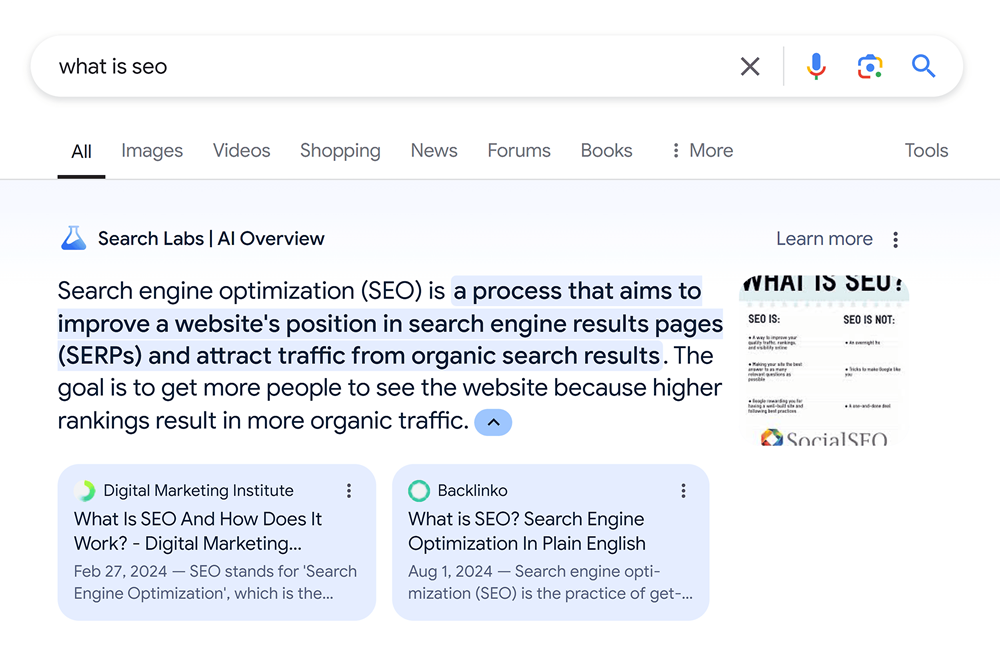
AI Overviews are Google’s AI-generated summaries shown at the top of search results. They give users a quick answer to their query in the form of a short paragraph, list, or table, along with links to the original sources.
Tested initially as the Search Generative Experience (SGE) in 2023, AI Overviews became a standard Google Search feature in 2024.
According to Google, these summaries are powered by Gemini, the company’s large language model, which scans multiple webpages, evaluates their authority and relevance, and generates a concise explanation, making them a key focus area in AEO vs GEO discussions.
Key characteristics of AI Overviews:
- Placement: Always displayed above the organic search results when triggered.
- Format: Can appear as short text, bullet points, comparison tables, or even step-by-step guides.
- Attribution: Links to source websites are included directly beneath the summary, giving users the option to click through for more detail.
- Frequency: Shown in over 50% of search queries, but not for every topic—Google prioritizes queries where a summary provides clear value, such as “how to,” “comparison,” or health-related questions.
What Google AI Overviews Look Like
The format of Google AI Overviews changes depending on the type of query. Instead of showing a single snippet, it pulls insights from multiple sources and reshapes them into different layouts.
Here are the main styles you’ll come across:
- Concise informational summaries – Short, multi-source explanations.
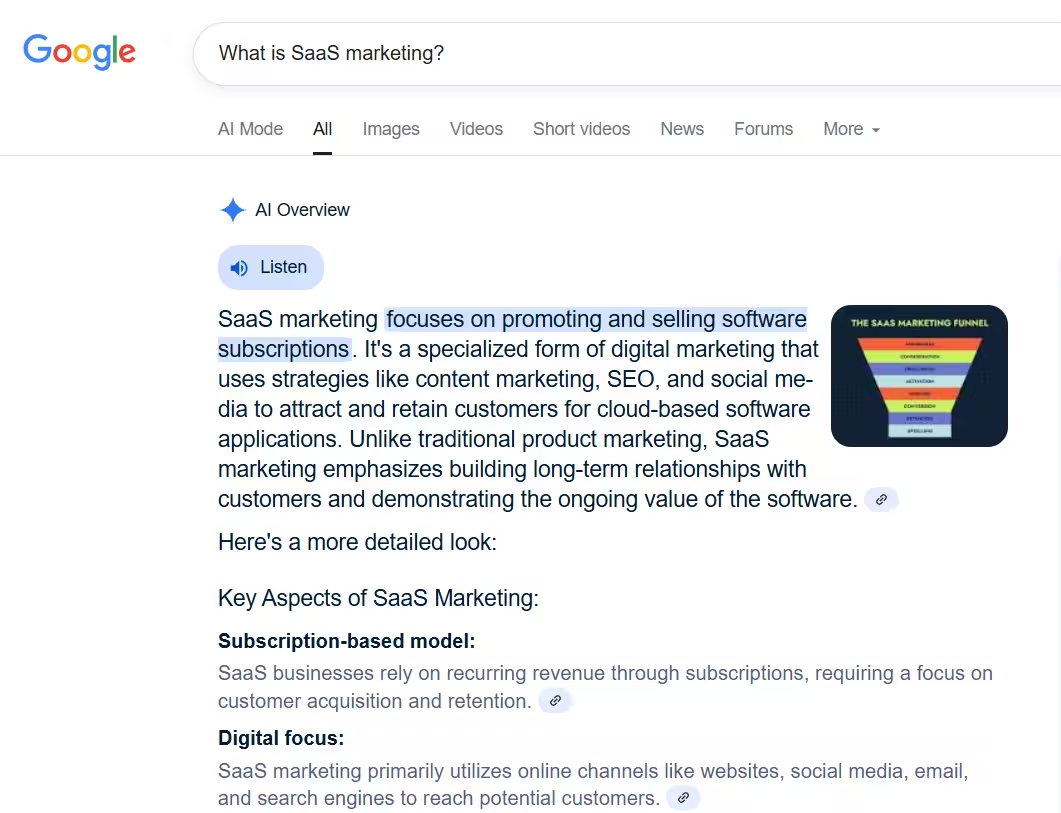
- Step-by-step instructions – Clear processes laid out in sequence.
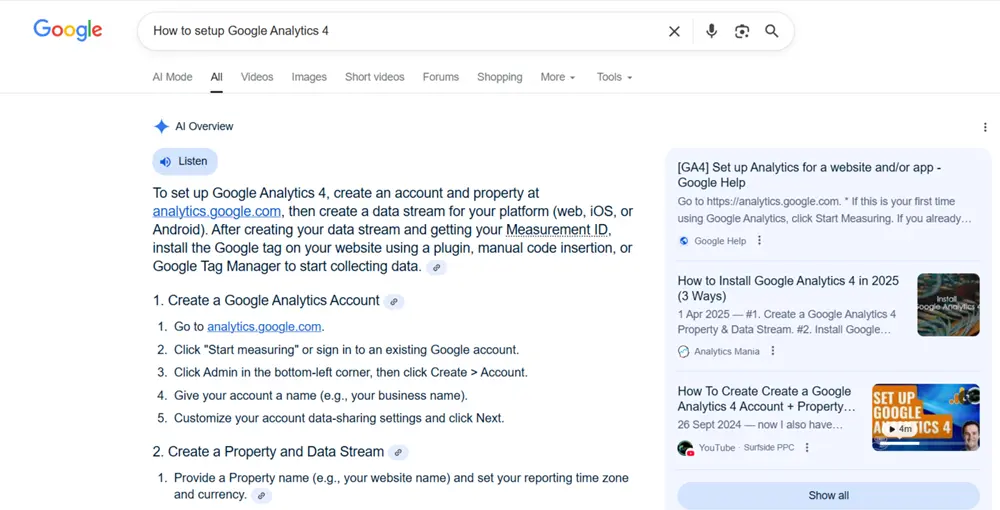
- Visual tables or lists – Quick-reference tables often paired with images.
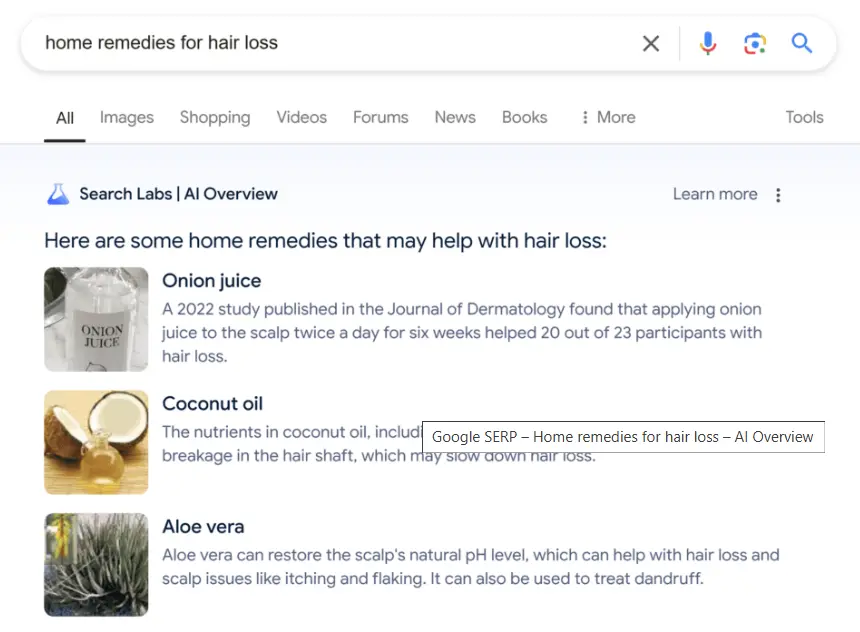
- Side-by-side comparisons – Pros, cons, or features directly contrasted.
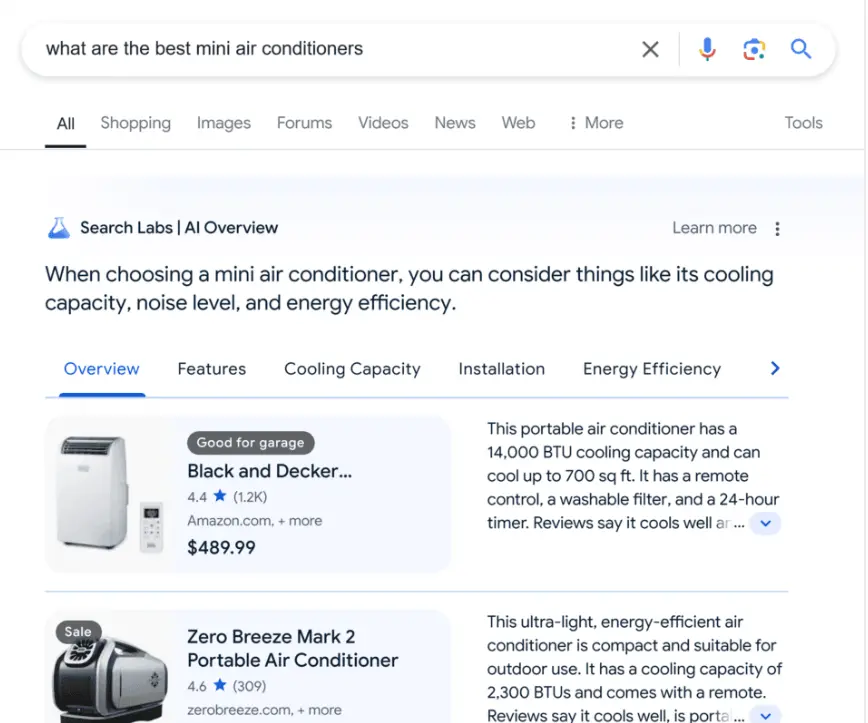
These are just some of the most common layouts you’ll see in Google AI Overviews.
Depending on the query, the format can shift even further, mixing charts, product carousels, location-based answers, or other interactive elements. The important part is that your content is structured so it can be surfaced in any of these variations.
AI Overviews SEO: How They Work and What Google’s Guidance Says
Google’s AI Overviews are powered by its Gemini model, which is trained to analyze SEO focused content across the web and generate short, source-backed explanations.
The process involves what Google calls query fan-out: when a user searches, Google expands the query into several related sub-questions. It then pulls answers from multiple webpages, evaluates which ones best demonstrate expertise and relevance, and compiles them into a single overview.
What Types of Searches Show Google AI Overviews?
AI Overviews in Google Search don’t appear at random; they’re most common when users are looking for deeper context or decision-ready answers. Current patterns suggest that several distinct search types trigger Overviews:
- Explanatory queries (informational)
- Direct questions
- Organizational or planning queries
- Product and shopping queries
- High-stakes (YMYL) queries
While these are the most visible today, Google continues testing. Over time, AI Overviews will likely expand into broader query types, meaning brands and content creators need to be ready across multiple search intents.
The key point: AI Overviews do not replace search ranking factors. Instead, they rely on Google’s existing systems, including:
- E-E-A-T (Experience, Expertise, Authoritativeness, Trustworthiness): Content from credible and knowledgeable sources is more likely to be cited.
- Page quality & technical SEO: Fast, crawlable, and well-structured sites stand a better chance of being selected.
- Content clarity: Pages that provide direct, well-formatted answers are easier for Google to summarize.
Quick Checklist for AI Overviews SEO
- Technical SEO (speed, mobile, crawlability)
- E-E-A-T signals (author bios, citations, expertise)
- Concise answers (40–60 words) under clear H2s/H3s
- Schema markup (FAQ, HowTo, QAPage, Product)
- Internal clusters + authoritative external links
- Optimized visuals: images, tables, videos
- Ongoing monitoring with SEO tools
- Reputation management across the wider web
- Natural, question-based formatting aligned with AEO
The recommendation is simple: continue following best practices for SEO and content quality.
What Are the Core Strategies for Google AI Overviews Optimization?
Here are the growth strategies to optimize for AI Overviews, with detailed explanations and examples.
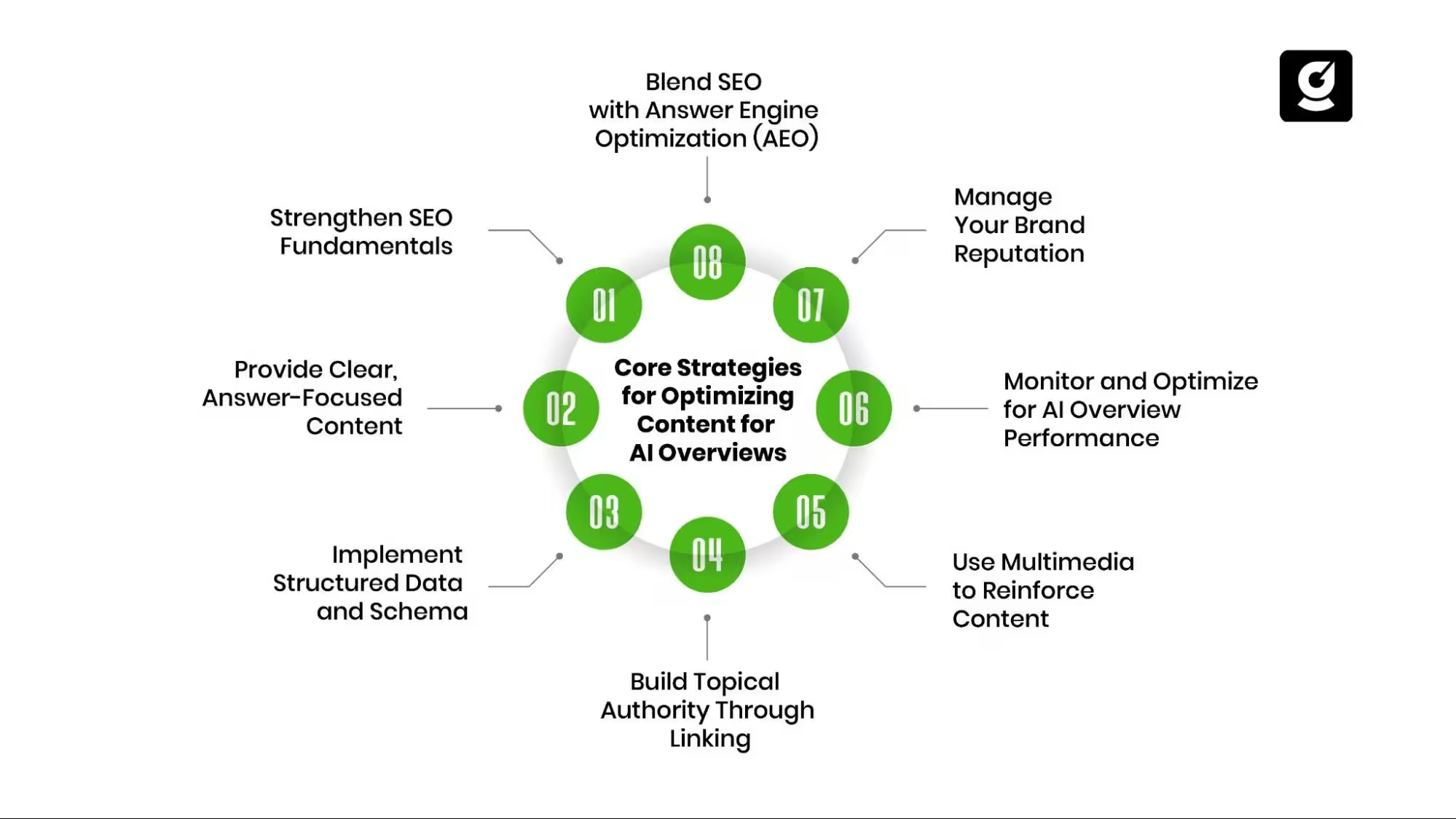
1. Strengthen SEO Fundamentals
Google has been clear: AI Overviews aren’t a separate ranking system. If your site struggles with basic SEO, it’s unlikely to surface in summaries.
-
Technical Health
Ensure your site has fast load times, a mobile-friendly design, secure HTTPS, and proper indexing. Use tools like Google Search Console to monitor and fix technical issues. A technically sound website improves user experience and helps reduce bounce rate, making it a prerequisite for all other SEO efforts.
-
Content Quality
Your pages must be original, accurate, up-to-date, and genuinely useful. Avoid thin or duplicated content, which has little chance of being selected for a summary.
AI Overviews are built on the highest quality content. Your content must offer real value to the user. -
E-E-A-T Signals
Showcase your site's Expertise, Experience, Authority, and Trustworthiness. Add author bios with credentials, cite credible sources, link to authoritative sites, and showcase first-hand experience (e.g., case studies, personal testimonials). These signals tell Google and the AI that your content is reliable and trustworthy.
-
Optimize for Conversational and Long-Tail Queries
Create content that directly answers specific, natural language questions (e.g., "How to grow tomatoes in a small garden" or "What are the best natural pesticides for houseplants?").
AI Overviews are designed to provide direct answers to conversational queries, so aligning your content with this format increases your visibility.
-
Structure Your Content for Clarity
Use clear headings (H2, H3, H4) to structure your content in a logical flow. Incorporate bullet points, numbered lists, and short paragraphs to break up text and present information concisely.
This scannable format makes it easier for the AI to identify and extract key facts and figures to construct its summary.
-
Add Structured Data (Schema Markup)
Use relevant schema markup, such as FAQPage, HowTo, or Article, to tell Google what your content is about explicitly. For example, use the FAQ schema for a list of frequently asked questions to help the AI pull those answers directly.
While not a direct ranking factor, schema provides a significant signal to the AI about the type and purpose of your content, increasing its chances of being selected for a summary.
2. Provide Clear, Answer-Focused Content
AI Overviews look for direct answers to questions. If your content buries key information under fluff, it will be overlooked. Your goal is to make it easy for the AI to find and quote the most important information.
Best practices:
- Front-load Answers: Open each section or paragraph with a concise, 40–60-word direct answer. Expand afterward with supporting details.
- Use Question-Based Subheadings: Use H2/H3 headings that are direct questions, such as “What is Google AI Overviews SEO?” This signals to the AI that the following text will contain the answer.
- Break Down Complexity: For complex topics, use bullet points, numbered steps, or short summaries to present information in a highly digestible format.
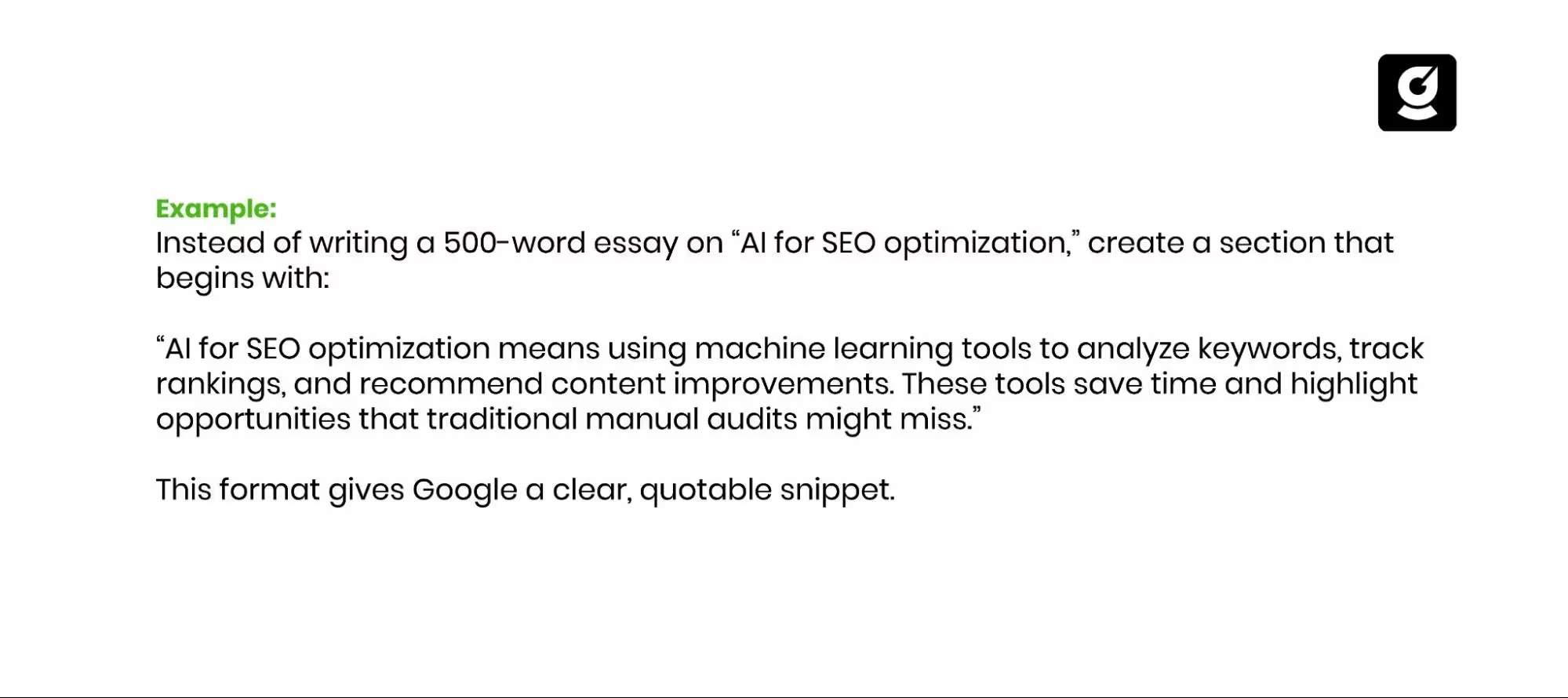
3. Implement Structured Data and Schema
Structured data helps Google parse and understand content. While it doesn’t guarantee inclusion, it makes your content easier to extract.
Types that work well for AI Overviews:
- FAQPage: This schema is perfect for questions and answers, allowing the AI to pull and display your content in a Q&A format directly.
- HowTo: Ideal for step-by-step guides and instructions, enabling the AI to present your content as a concise list of steps.
- QAPage: This is specifically for community-driven questions and answers, making it perfect for forum-style content on niche topics.
- Product schema: For e-commerce sites, this schema helps the AI understand product details like specifications, ratings, and pricing.
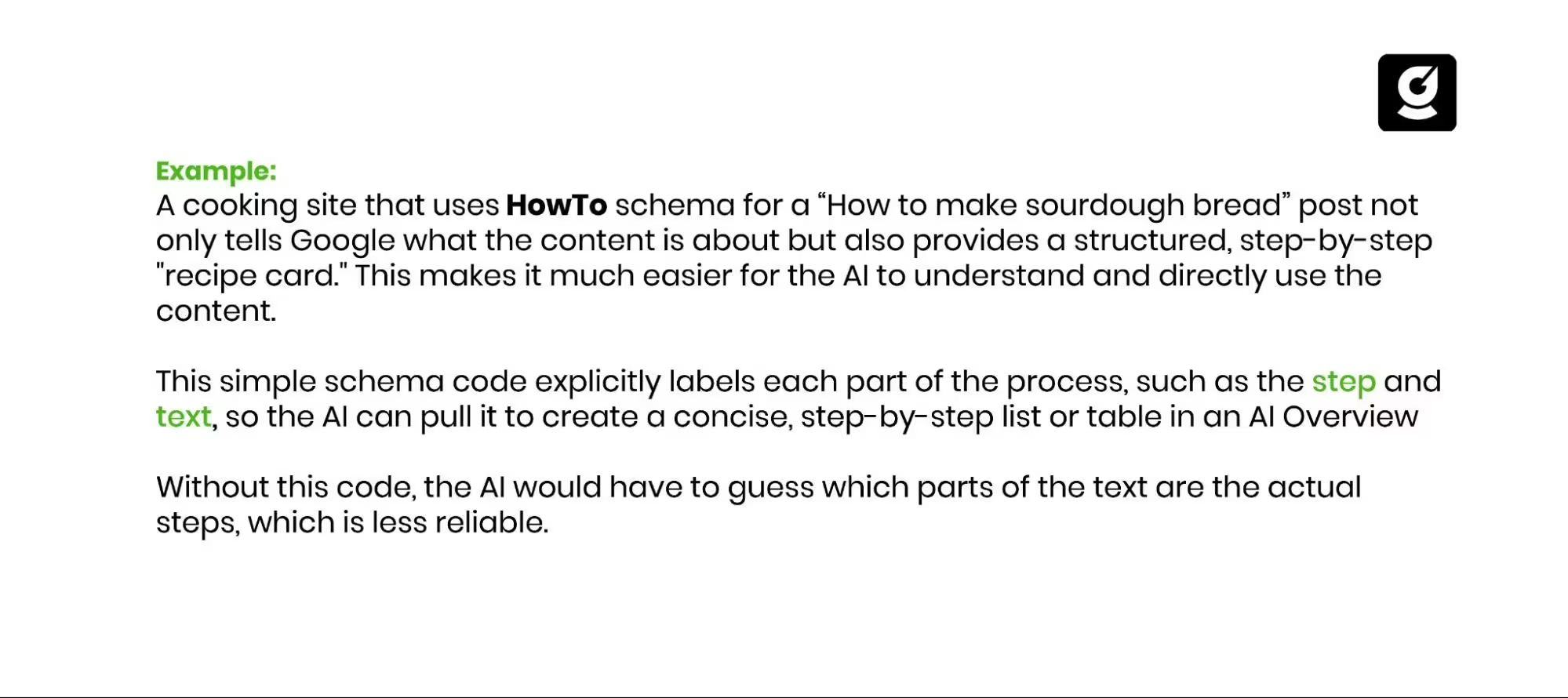
4. Build Topical Authority Through Linking
Google looks for topic experts, not just isolated answers. Building topical authority means positioning your site as a comprehensive, trustworthy resource on a specific subject.
This increases your likelihood of being cited in an AI Overview. The goal is to show the AI that you have a holistic understanding of a topic, not just a single piece of information.
Internal linking:
- Create Topic Clusters: Organize your content into topic clusters or "hubs." For example, a cluster on “AI for SEO optimization” might include a main "pillar" page and supporting articles on related subtopics like keyword analysis, competitor research, and other tools.
- Use Descriptive Anchor Text: Use descriptive anchor text that signals the relevance of the target page. Instead of "click here," use phrases like "AI-powered keyword research tools."
External linking:
- Reference Authoritative Sources: Link out to credible, high-authority sources such as academic studies, industry whitepapers, or official documentation from Google. This demonstrates that your content is well-researched and grounded in verifiable information.
- Avoid Poor-Quality Links: Just as good links build trust, links to low-quality or irrelevant sites can weaken it. Be selective and avoid linking to sites that can compromise your credibility.
5. Use Multimedia to Reinforce Content
AI Overviews are designed to provide the most useful information in a variety of formats, often extracting images, lists, and tables directly from a source.
Content with useful, well-optimized visuals is far more likely to be featured because these elements offer a clear, scannable summary of key information.
Tips for multimedia:
- Add Optimized Images: Use high-quality, relevant images and always include descriptive alt text.
The alt text of all your images should accurately explain the image and its context because this helps both Google and your readers with screen readers understand the content. - Include Comparison Tables: Create tables for direct comparisons (e.g., “Top AI SEO tools in 2025”).
These are extremely valuable for AI Overviews because they present data in a structured format that is easy to extract and use to build a quick summary or list. - Use Infographics and Short Videos: For explaining complex processes or data, use infographics or short, informative videos.
These assets can serve as visual summaries that are highly engaging and easily digestible for both users and AI models.
6. Monitor and Optimize for AI Overview Performance
Optimization doesn’t end after publishing. AI Overviews are a dynamic feature of Google Search, and your site's inclusion can change week to week based on algorithm updates and user behavior.
How to monitor:
- Use Google Search Console: Regularly check the Performance Report in GSC. Look for queries where your pages have high impressions but low clicks. This can indicate that an AI Overview is answering the user's query before they click through to your site.
- Use Third-Party Tools: Use platforms like SEMrush, Ahrefs, or SimilarWeb to track which of your target keywords and queries are triggering AI Overviews. These tools can often identify when your domain is being cited in a summary.
- Conduct Content Audits: If your content isn't being cited, conduct an audit. Re-examine your structure, schema markup, and authority signals. Look for opportunities to be more direct and answer-focused.
- Refresh and Update: Practice content decay analysis by identifying and updating older posts that are losing traffic. Refreshing content with the latest information, new data points (e.g., "2025" in a title), and updated schema can significantly improve its chances of being featured.
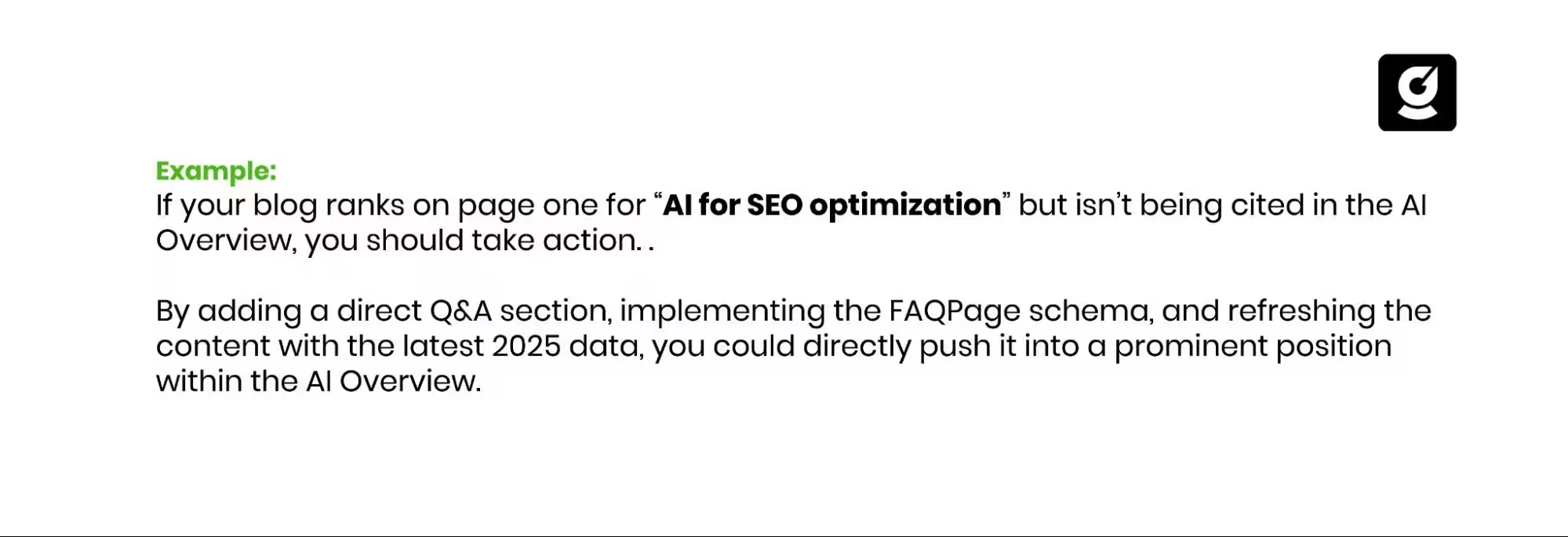
7. Manage Your Brand Reputation
AI Overviews often cite forums, Q&A platforms, and reviews to build a complete picture of a brand.
Managing your brand’s reputation across the web is crucial because it directly influences Google's E-E-A-T signals, particularly Trustworthiness and Authoritativeness.
If the broader web views you as a trusted expert, the AI is more likely to feature your content.
Steps to take:
- Maintain Your Google Business Profile: Keep your profile accurate and up-to-date with correct hours, contact information, and business descriptions. Actively manage and respond to reviews on this platform.
- Encourage and Respond to Reviews: Actively encourage customers to leave reviews on industry-specific platforms and major review sites like G2, Capterra, and Yelp. Proactively and professionally respond to both positive and negative feedback. This shows that your brand is engaged and cares about its customers, which builds trust.
- Monitor User-Generated Content: Actively monitor forums and Q&A platforms like Reddit and Quora for mentions of your brand. Google's AI models are specifically trained to extract information from these user-generated platforms.
- Correct Misinformation: Address any negative or inaccurate mentions about your brand quickly and publicly, if appropriate. This proactive approach helps control your brand narrative and ensures the AI doesn't surface outdated or false information.
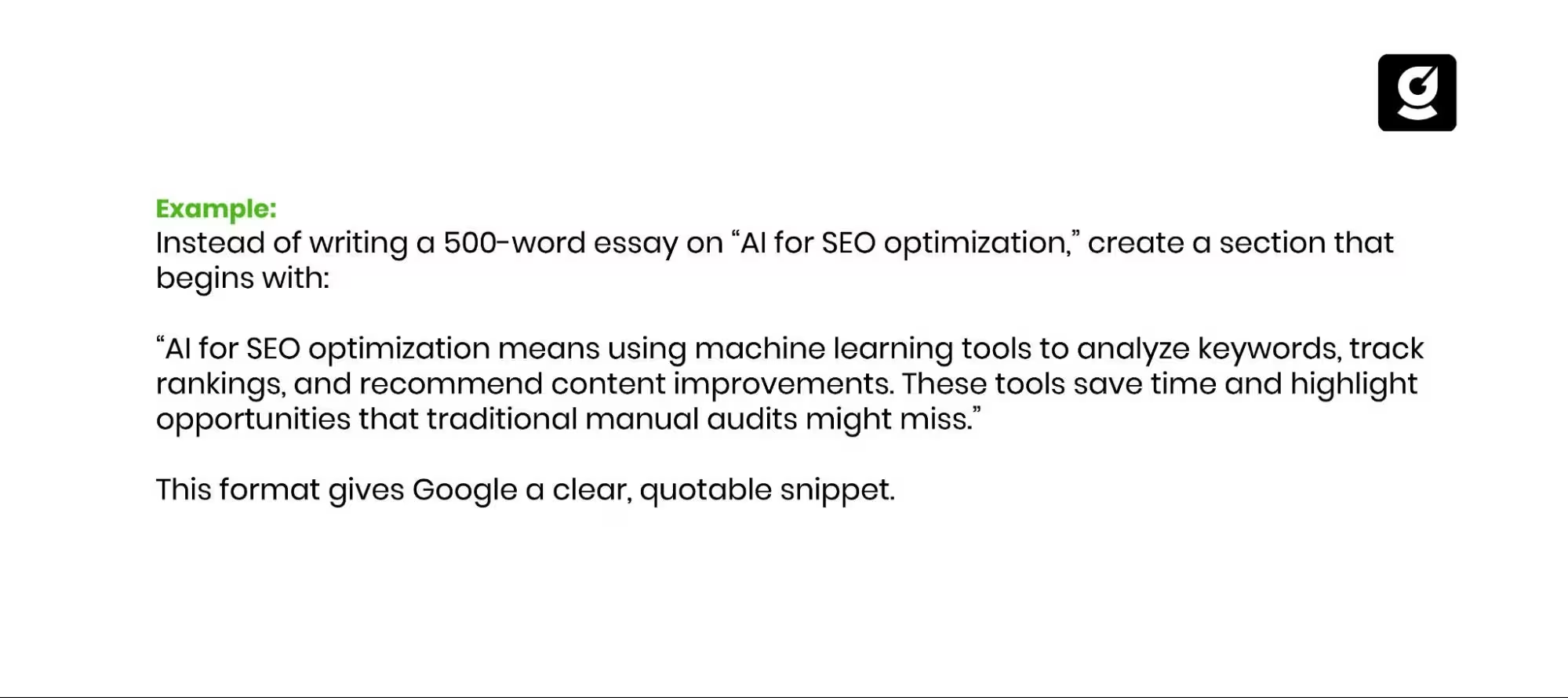
8. Blend SEO with Answer Engine Optimization (AEO)
AI Overviews reflect the larger shift toward Answer Engine Optimization (AEO), where search engines aim to directly answer conversational questions rather than simply displaying a list of links.
Think of it as moving from providing a library to providing the exact book and page number the user needs. While SEO gets you ranked, AI SEO services and AEO get you selected.
How to optimize for AEO:
- Write for Conversational Intent: The foundation of AEO is anticipating and directly answering the questions your audience asks. Use natural language and structure your content around these queries. Don't just target keywords; target the underlying user intent.
- Cover Topics Comprehensively: Instead of creating a shallow snippet for a single keyword, build out content that covers a topic from all angles. The AI is looking for an expert, and a comprehensive topic cluster shows you are one.
- Structure for Parsability: The content needs to be not only comprehensive but also easy for an AI to understand. This means using a clear hierarchy with H2s and H3s, bullet points, numbered lists, and short, direct paragraphs.
- Prioritize Concise: While you should cover a topic in depth, each individual answer or section should be concise and to the point. The AI is looking for clean, quotable snippets. Your introductory paragraphs, in particular, should provide the direct answer upfront.
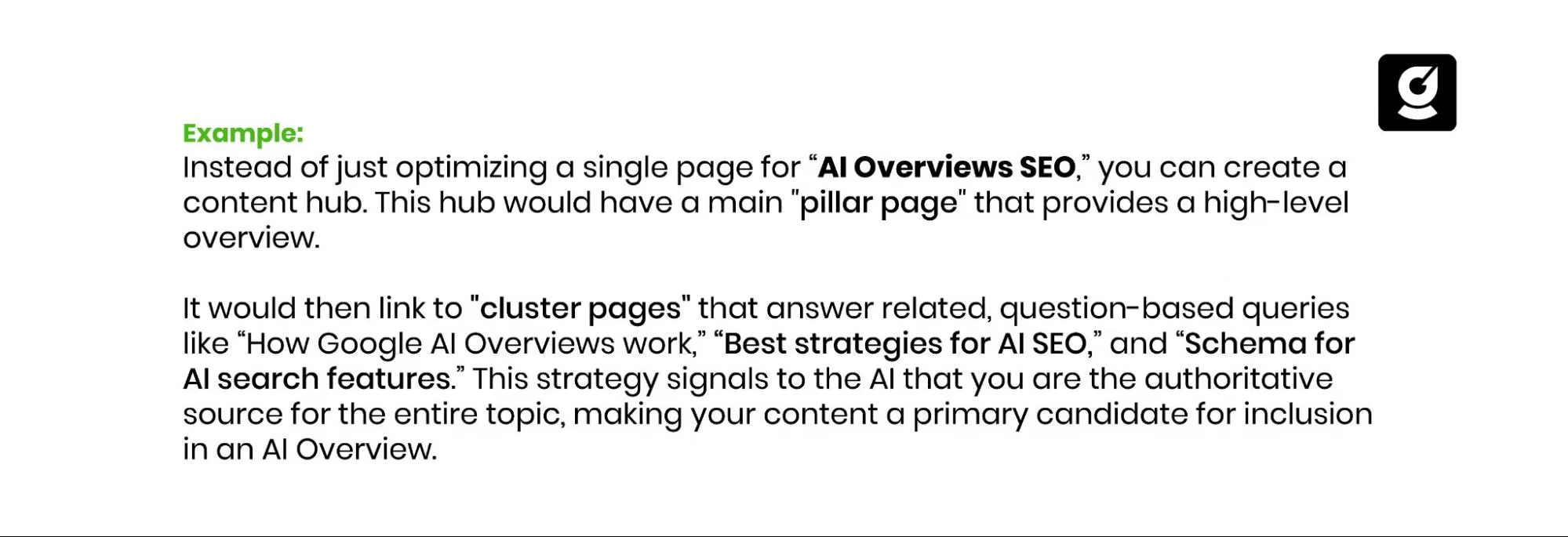
What Does the Future of Google AI Overviews Optimization Look Like?
For marketers and SEO professionals, including those working in SaaS SEO, this means strategies cannot remain static. You need to plan for an environment where AI-driven summaries will play a bigger role in how searchers find and consume information.
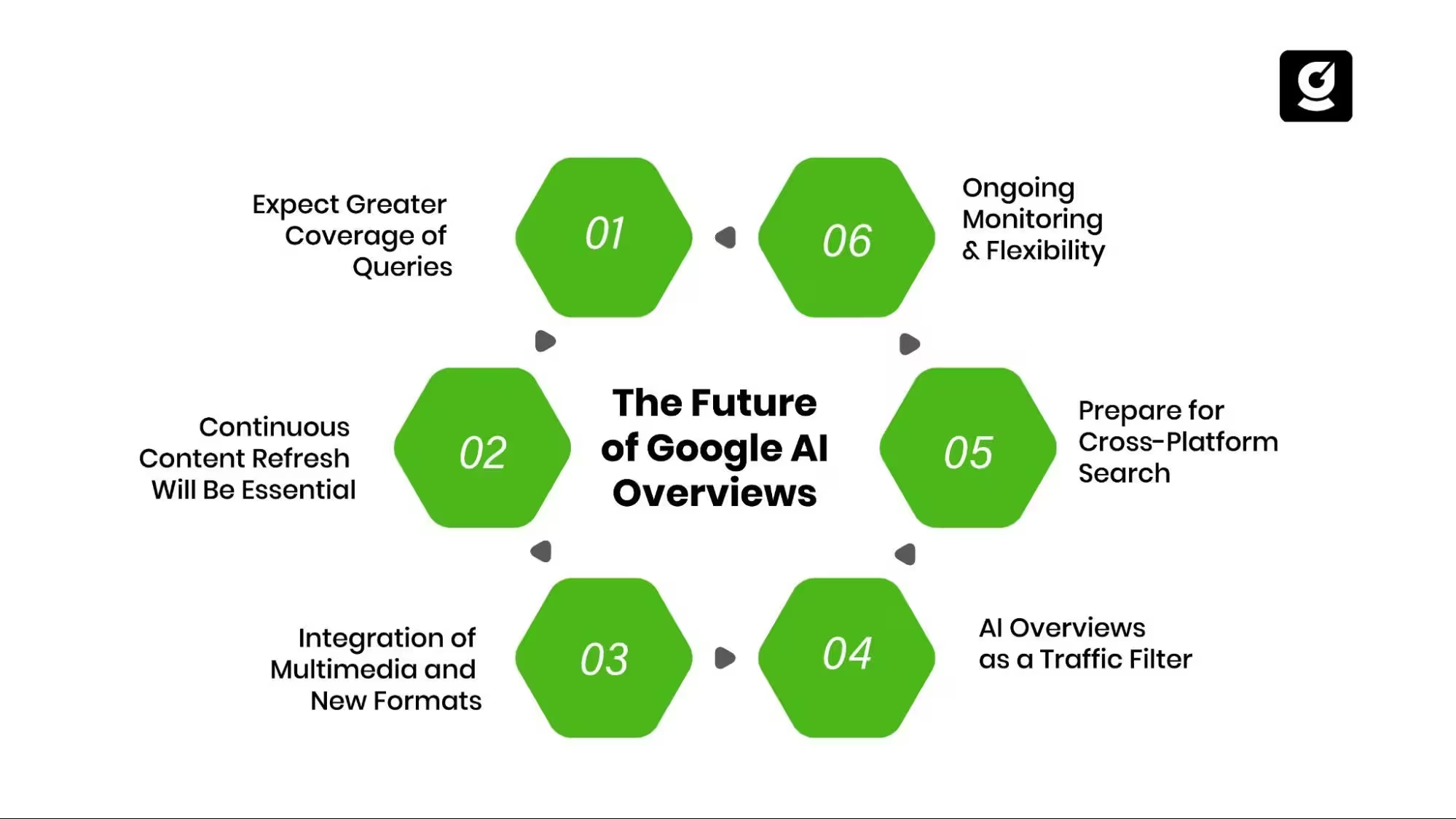
Expect Greater Coverage of Queries
AI Overviews will appear in a wider range of searches, from complex informational questions to comparisons and step-by-step processes.
Continuous Content Refresh Will Be Essential
Static pages will fade in visibility. Regularly updating statistics, examples, and FAQs will be necessary to stay included.
Integration of Multimedia and New Formats
Overviews will increasingly highlight charts, explainer videos, and interactive elements, favoring content that provides these resources.
AI Overviews as a Traffic Filter
Quick answers may reduce clicks for simple queries, but users seeking details will still turn to full guides and in-depth resources.
Prepare for Cross-Platform Search
Optimization for Google also strengthens visibility across Bing, Perplexity, and ChatGPT as all move toward AI summaries.
Ongoing Monitoring and Flexibility
Performance will shift with each update, making tracking, testing, and adaptation a continuous process for success.
Conclusion
Google’s AI Overviews represent a shift in how information is surfaced and consumed online. For brands and publishers, visibility is no longer guaranteed by rankings alone—it depends on whether your content is trusted enough to be cited directly in AI-generated summaries.
Optimizing for AI Overviews requires two priorities. First, refining today’s fundamentals: clear answers, structured formatting, and content that aligns with searcher intent. Second, preparing for tomorrow: continuously refreshing content, strengthening authority, and staying flexible as Google evolves its systems.
Those who act early will not only maintain visibility but also gain credibility as reliable sources in a search environment that increasingly rewards precision and authority. AI Overviews may change traffic flows, but they also open the door to stronger brand recognition and influence.
If you’re looking for expert guidance on AI SEO optimization for SaaS growth, growth.cx, a leading SaaS marketing agency, is the right partner. The team specializes in helping SaaS companies stay ahead of search changes, and you can book a call with them to explore customized strategies for ranking in Google’s AI Overviews.
Stay Ahead of the AI Search Curve
AI Overviews may change traffic flows, but they also open the door to stronger brand recognition. Let's build a strategy that keeps you visible.